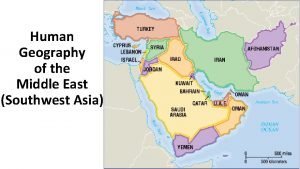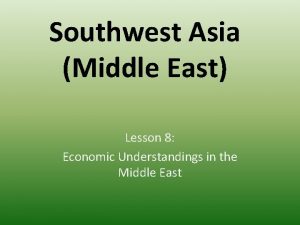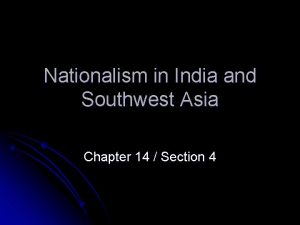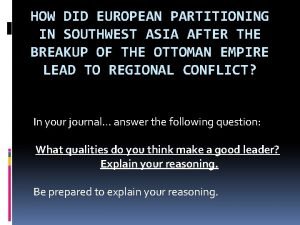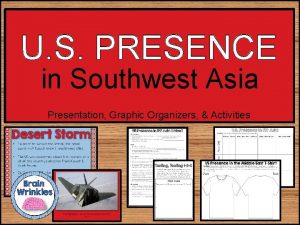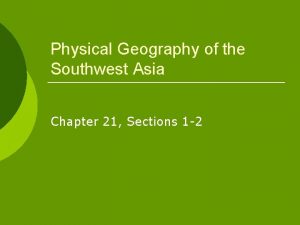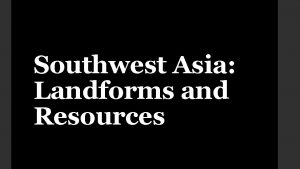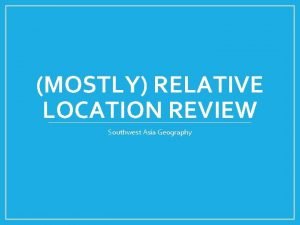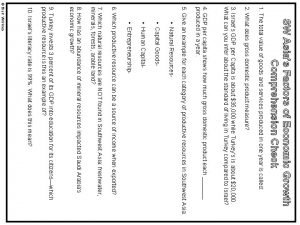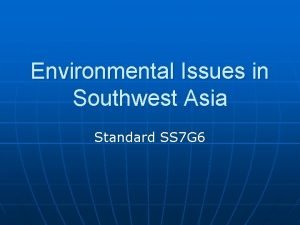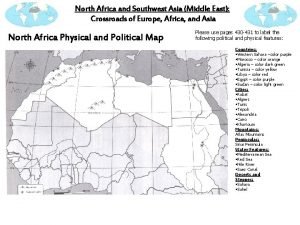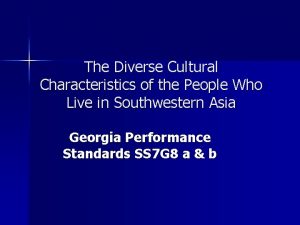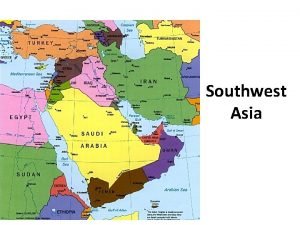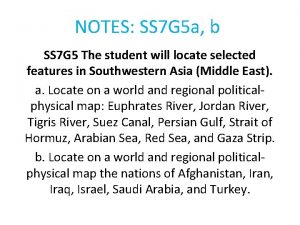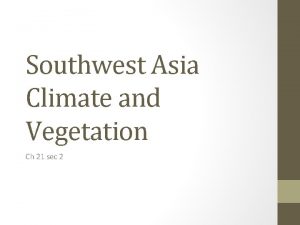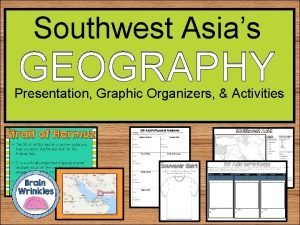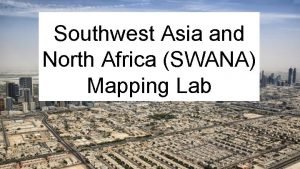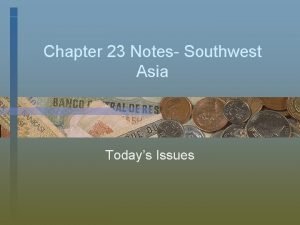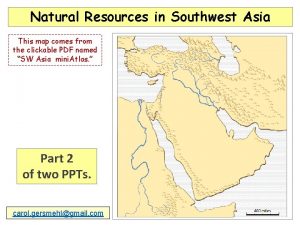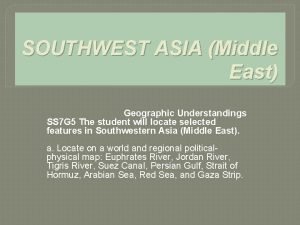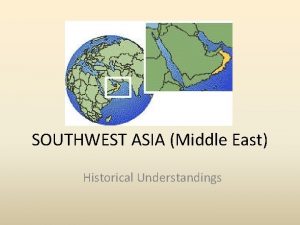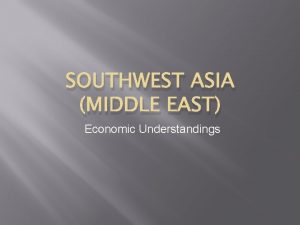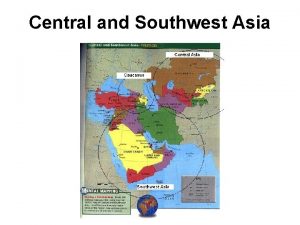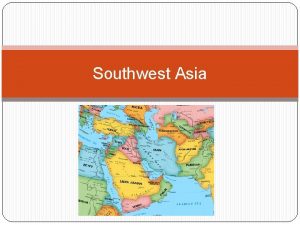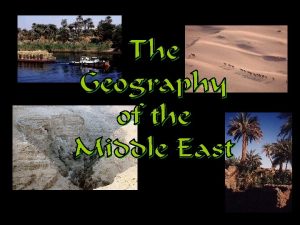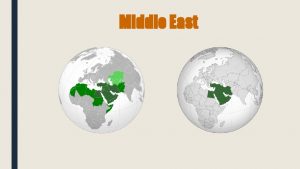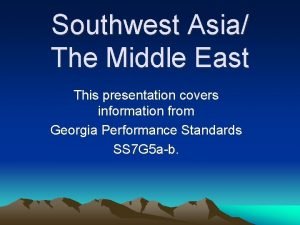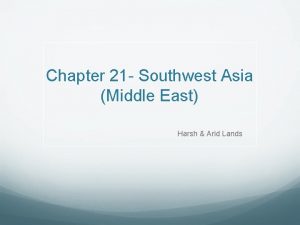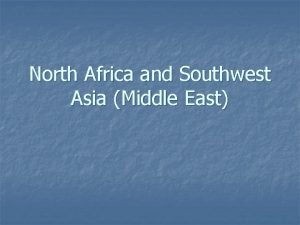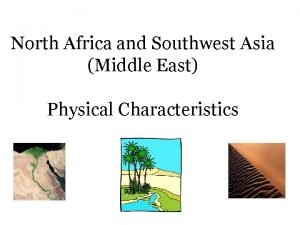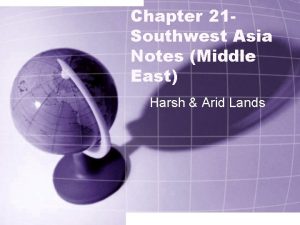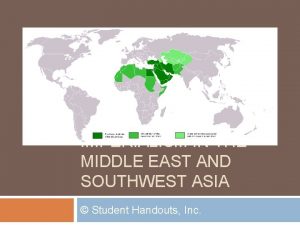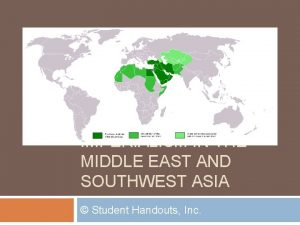GEOGRAPHIC UNDERSTANDINGS OF SOUTHWEST ASIA THE MIDDLE EAST






























- Slides: 30

GEOGRAPHIC UNDERSTANDINGS OF SOUTHWEST ASIA THE MIDDLE EAST SS 7 G 5, 6, 7, 8

I. Physical Features and Nations of S. W. ASIA A. Israel 1. Crossroads between Asia and Africa. 2. Traders and armies going from Asia and Africa have had to travel through this area. 3. Empires and nations throughout history have sought to control the territory because of its location.

A. Israel (continued) 4. Occupied Territories of Israel. a. Areas taken from Arab nations following a war. b. In the north – Golan Heights 1) Allows Israel to control crucial high ground from which they can defend themselves from their enemy, Syria.

A. Israel (continued) c. West Bank- area along the west bank of the Jordan River and East Jerusalem. d. Great tension between Arabs and Israelis. 1) Arabs want land back. 2) Israelis say they won it when Arab attacked them and Israel won. 3) Israeli settlers moved into these areas, Arabs often respond with violent protests.

A. Israel (continued) 5. Capital of Israel is Jerusalem. a. Sacred city 1) Jews- King Solomon’s temple 2) Christians- Jesus crucified and rose from dead 3) Muslims – Muhammad ascended to heaven

A. Israel (continued) 6. Christians and Muslims fought for Jerusalem during the Crusades. 7. In 1948, Israel became an independent nation and occupies all of Jerusalem especially after the Six Day War.

B. The Gaza Strip 1. Israel oversees the Gaza Strip along the Mediterranean coast between Israel and Egypt. 2. Most people who live here are Palestinians. They resent Israel. a. 38 yrs Israel’s military occupied the area. b. In 2005, the Israelis pulled out and radical Palestinian groups have used Gaza to launch attacks against Israel.

B. The Gaza Strip (continued) c. Israel has been accused of striking back and hurting innocent civilians living there. d. In 2008, Israel cut off fuel and electricity to the Gaza Strip to end the Palestinian strikes.

C. Saudi Arabia MECCA 1. Found in most of the Arabian Peninsula. 2. The Red Sea is to the west of Saudi Arabia and the Persian Gulf is to the east. 3. Saudi Arabia exports more oil than any other nation on earth. MEDINA 4. Oil accounts for over 2/3 of the Saudi government’s revenue. 5. It is the home of Mecca and Medina, the two holiest cities in Islam.

C. Saudi Arabia (continued) 6. Mountain ranges run along the west. 7. Plateau of Nejd covers much of the nation’s center. 8. Rocky and sandy lowlands on the eastern side along the Persian Gulf. 9. South is covered by dry, harsh desert. 10. Climate is extremely hot and dry.

C. Saudi Arabia (continued) 11. Saudi Arabia is a Muslim state. 12. The Qur’an, other Muslim writings, and generations of tradition combine to form Saudi Arabia’s laws. 13. These laws greatly restrict women’s rights. 14. The Saudis also practice a strict legal code, beat offenders or cut off their hands or death for crimes.

C. Saudi Arabia (continued) 15. Most Saudis are Arabs. 16. 200, 000 Palestinians live in Saudi Arabia. 17. Saudi Arabia will not give citizenship to these Palestinians because it would lead to the loss of Palestinian identity and the end of anti-Israeli resistance. 18. Saudi Arabia hosts many foreign workers, in its oil industry.

D. Iraq 1. Lies east of Syria, Jordan, and Saudi Arabia. 2. It is west of Iran. 3. Area is known as “cradle of civilization. ” 4. Capital is Baghdad. 5. Country is mostly desert.

D. Iraq (continued) 6. 2 of the world’s oldest and most important rivers run through the country: a. Tigris River 1) runs south out of Turkey and past Baghdad then joins the Euphrates River. b. Euphrates River 2) Empties into the Persian Gulf south through Syria and Iraq.

D. Iraq (continued) 7. Mountains cover most of the northern Iraq. 8. Winters are mild an cool with summers being extremely hot and dry. 9. In the higher mountain elevations, cold winter produce snowfalls that can cause flooding in the Spring. 10. Has abundant oil and natural gas reserves. 11. Experts say that close to 90% of Iraq’s oil is yet to be drilled.

E. Iran 1. Once known as Persia, sits at the heart of the Persian Gulf. 2. It is one of the largest countries in Southwest Asia. 3. Most of Iran sits in the Iranian Plateau. 4. Very mountainous country with large populations living in the west. 5. Eastward lie desert regions because of the western mountains preventing rain from reaching them.

E. Iran (continued) 6. Persian (Farsi) is the official language not Arabic. 7. Various ethnic groups call Iran home: a. b. c. d. e. Azeris Turks Kurds Arabs Persians 8. Iran is home to the world’s oldest civilizations. 9. Iran is abundant in oil and is the major source of income for the country.

F. Afghanistan 1. Sits directly east of Iran. 2. Crossroad of eastern and western Asia. 3. Has historically been an important area for trade and is home to a diverse population. 4. It is extremely mountainous. 5. Has no borders on any bodies of water 6. Very dry, hot and extremely cold in winter. 7. Because of its location has lots of earthquakes.

G. Turkey 1. Covers the Anatolian Peninsula in Southwest Asia. 2. It lies at the crossroad of Europe and Asia. 3. The modern Republic of Turkey was founded after WWI and the fall of the Ottoman Empire.

II. Physical Features A. Important bodies of Water 1. Rivers a. Tigris River runs through Turkey, Iraq, Kuwait b. Euphrates River runs through Turkey, Syria, Iraq, Kuwait c. Jordan River runs along the border between Jordan, Syria, West Bank and Israel. 1) Considered a sacred river a) Jews believe it is the river Joshua crossed in

A. Important Bodies of Water 2. Suez Canal a. A man made waterway across part of Egypt. b. It connects the Mediterranean Sea and the Red Sea. c. It allows ships to travel back and forth between two bodies of water without having to travel around the south of Africa.

A. Important Bodies of Water 3. Red Sea a. Sits between North Africa and the Arabian Peninsula’s western shore. b. It has long allowed Asia and Africa to engage in trade with one another by water, while providing countries like Egypt access to the Indian Ocean.

A. Important Bodies of Water 4. Persian Gulf a. Separates the eastern shore of Arabian Peninsula and Iran. b. Nations around the world recognize its importance to the world economy. c. It provides trading access for the abundant oil exports from Iran and the Arabian Peninsula. d. This importance also makes it an area where many wars are fought.

A. Important Bodies of Water 5. Strait of Hormuz 5. A narrow strait that connects the Persian Gulf to the Arabian Sea.

B. Arabian Desert South. Rub’al. Khali (Empty Quarter) Middle. Ad Dahna’ North- An Nafud and Syrian Desert

C. More Deserts Turkmenuistan. Kara Kum Iran – Dasht e-Kavir & Dash-e Lut

D. Mountains Turkey – Taurus Mts. Azerbaijan – Caucasus Iran – Elburt Mts Zagros Mts.

Mountains Afghanistan – Elburt Mts. Zagros Mts. Saudi Arabia – Hejaz Mts. Asir Mts. Yemen – Hadramawt

Turkey Saudi Arabia Israel Gaza Strip Iraq Afghanistan Iran

Jordan River Tigris River Persian Sea Euphrates River Suez Canal Red Sea Arabian Sea Strait of Hormuz
 Is middle east in asia
Is middle east in asia Lesson 8 middle east and south asia
Lesson 8 middle east and south asia North american
North american North africa southwest asia physical map
North africa southwest asia physical map Nationalism in india and southwest asia
Nationalism in india and southwest asia Why is water pollution a great concern in southwest asia
Why is water pollution a great concern in southwest asia Europe partitioning in southwest asia answer key
Europe partitioning in southwest asia answer key Brain wrinkles southwest asia
Brain wrinkles southwest asia Somebody wanted but so us presence in sw asia
Somebody wanted but so us presence in sw asia Brain wrinkles southwest asia
Brain wrinkles southwest asia Brain wrinkles southwest asia answer key
Brain wrinkles southwest asia answer key Nationalism in india and southwest asia
Nationalism in india and southwest asia Map of southwest asia
Map of southwest asia Dubai landforms
Dubai landforms Iraq relative location
Iraq relative location Why is water pollution of great concern in southwest asia
Why is water pollution of great concern in southwest asia North africa and southwest asia physical geography
North africa and southwest asia physical geography Landform in asia
Landform in asia Sw asian economies comprehension check answer key
Sw asian economies comprehension check answer key Environmental issues in southwest asia
Environmental issues in southwest asia North africa and southwest asia physical map
North africa and southwest asia physical map Which ethnic group is most numerous in southwest asia
Which ethnic group is most numerous in southwest asia Chapter 21 physical geography of southwest asia
Chapter 21 physical geography of southwest asia Jordan river southwest asia map
Jordan river southwest asia map Chapter 22 human geography of southwest asia
Chapter 22 human geography of southwest asia Southwest asia vegetation
Southwest asia vegetation Brain wrinkles southwest asia
Brain wrinkles southwest asia Swana map
Swana map Christianity vs judaism vs islam chart
Christianity vs judaism vs islam chart Chapter 23 today's issues southwest asia
Chapter 23 today's issues southwest asia How would you describe this
How would you describe this
